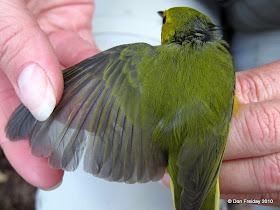Hotline: Cape May Birding Hotline
To Report: call (609) 884-2736, or email sightingsATbirdcapemay.org
Coverage: Cape May, Cumberland and Atlantic Counties , NJ
Compiler: David Lord, Cape May Bird Observatory with additions by Don Freiday
URL: http://www.njaudubon.org ; http://www.birdcapemay.org
This is the Cape May Birding Hotline, a service of New Jersey Audubon Society's Cape May Bird Observatory. This week's message was prepared on Thursday, July 22, 2010. Highlights this week include sightings of BLACK-BELLIED WHISTLING DUCK, SANDWICH TERN, and WHITE-FACEDxGLOSSY IBIS hybrid.
-For up-to-the-minute Cape May sightings information, photos and downloadable birding maps and checklist of Cape May, visit www.birdcapemay.org . Follow rarity sightings and spectacles on www.twitter.com/CMBObirds -
3 BLACK-BELLIED WHISTLING DUCKS were located at Cape May Point State Park on Bunker Pond on Sunday, July 18, 2010, and were last seen Thursday, July 22, 2010 on Lighthouse Pond from the bird blind.
A SANDWICH TERN was seen on Bunker Pond on Tuesday, July 20, 2010.
An apparent WHITE-FACED IBIS x GLOSSY IBIS hybrid was seen on Bunker Pond on Tuesday, July 13th, 2010.
ANNOUNCEMENTS:
If you appreciate this hotline service, and care about the birds of Cape May, please consider becoming a member of Cape May Bird Observatory.
******CMBO SUMMER HOURS are as follows: Northwood Center on East Lake Drive in Cape May Point is open daily, 9:30 a.m. to 4:30 p.m. The Center for Research and Education on Rt. 47 in Goshen is open Tuesday through Saturday, 9:30am to 4:30pm; closed Sundays and Mondays ******
The Cape May Birding Hotline is a service of the New Jersey Audubon Society's Cape May Bird Observatory and details sightings from Cape May, Cumberland and Atlantic Counties. Updates are made weekly. Please report sightings of rare or unusual birds to CMBO at 609-884-2736. Sponsorship for this hotline comes from the support of CMBO members and business members, and should you not be a member, we cordially invite you to join. Individual membership is $39 per year; $49 for families. You can call either center to become a member or visit. Become a member in person and you'll receive a FREE gift (in addition to member discounts in the stores).
Good Luck and Good Birding!
 [This Great-horned Owl has been detected with great consistency on CMBO's Friday evening meadows walk. Photo by Karl Lukens, click to enlarge.]
[This Great-horned Owl has been detected with great consistency on CMBO's Friday evening meadows walk. Photo by Karl Lukens, click to enlarge.]


















































